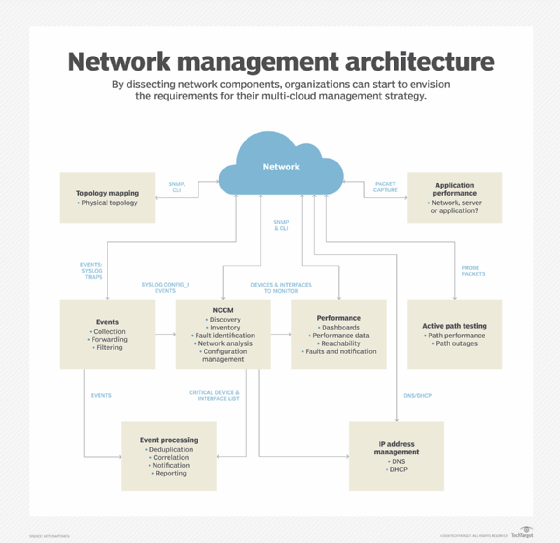
animind - Fotolia
A glossary of network terms for management and monitoring
This glossary of network terms specifically highlights network management and monitoring processes. Explore these 12 key terms and concise definitions.
As networks change and transform due to advancements such as automation and software-defined concepts, network management and monitoring must keep pace.
Network management and monitoring are universally crucial for organizations, regardless of location, workload or size. The moving pieces in these aspects of networking can seem complicated, especially as times and technologies change, but those factors also increase the importance of how network teams manage and monitor their networks. In addition to universal importance, network management and monitoring are also universal when it comes to protocols, issues and processes. Most networks face similar issues -- such as bottlenecks and outages -- that the use of the same protocol and similar best practices can fix.
This glossary of network terms specifically focuses on network management and monitoring. This guide of 12 terms brings together the various ubiquitous components that networks share, including common issues, shared protocols and streamlined processes for enhanced network performance.
Network management and monitoring terms
Bottleneck. Like with vehicles in traffic, a network bottleneck occurs when the amount of traveling data becomes too great and slows or halts traffic flows. Bottlenecks negatively affect network or application performance and can lead to crashes or downtime. Proper network management and monitoring can lower the potential for bottlenecks, and monitoring software can alert network administrators to resolve the issue.
Command-line interface. A CLI is a text-based interface network teams use to manually control and look over computer data and files. CLI commands can provide quick, granular OS management and benefit troubleshooting processes. Admins commonly use CLI commands with Linux servers for network management and monitoring.
Network analytics. Network analytics is the term used for various techniques involved in security, network management and monitoring operations. More specifically, network analytics provides IT teams with insight into network performance and data about how users operate within a network. This information can benefit network management and monitoring, as network analytics tools enable teams to enhance troubleshooting, performance and security processes.
Network automation. Network automation involves software that can manage, monitor and control various devices on an organization's network or software that can automate network processes. Network automation affects modern network management and monitoring capabilities, as it can reduce the potential for human error and streamline network operations.
Network configuration management. Network configuration management oversees network configurations, or the cumulated information of all network components. This database includes historical information from a network's devices, programs and updates, which helps simplify network management and monitoring in terms of how IT teams handle potential network changes or upgrades.

Network engineer. A network engineer is a person that controls and oversees network operations and services, such as troubleshooting processes and network security configurations. Network management and monitoring are a large portion of a network engineer's job description.
Network monitoring. Network monitoring is a process designed for IT teams and network engineers to oversee -- or monitor -- a network. Network monitoring tools oversee network hardware and software and can tell if a network component fails and then alert IT teams to help avoid an outage. Network monitoring can benefit network security and help users visualize IT performance infrastructure.
open source. Open source is publicly available source code that any user can take advantage of. Users can take open source software, use it and modify it to fit their specific needs. Some open source network monitoring software tools includes Zabbix and Nagios Core.
Protocol. A network protocol is a set of regulations for how network devices should send, view and receive data to enable clear communication across networks. Protocols also provide a mutual language for different devices or endpoints to communicate with. Protocols are a major part of network management and monitoring and help prevent potential issues that network monitoring software could cause to network components.
Real-time monitoring. With real-time monitoring, IT teams can instantly receive information about events on a network. This type of monitoring can enable teams to see trends develop on their networks and make informed decisions about network management and monitoring components.
Simple Network Management Protocol. Like CLI commands, SNMP provides network control and visibility to IT teams. SNMP can benefit large networks in particular because the protocol has a single interface for IT teams to view and control a significant amount of network nodes in a single, streamlined area. SNMP is also common in Linux servers for network management and monitoring.
Virtual systems management. Virtual systems management enables IT teams to remotely manage and monitor components and actions of networks and virtual network components, such as virtual servers or VPNs. This management has a single streamlined console for IT teams to monitor network components and manage OS operations without any disruption to systems or applications.







